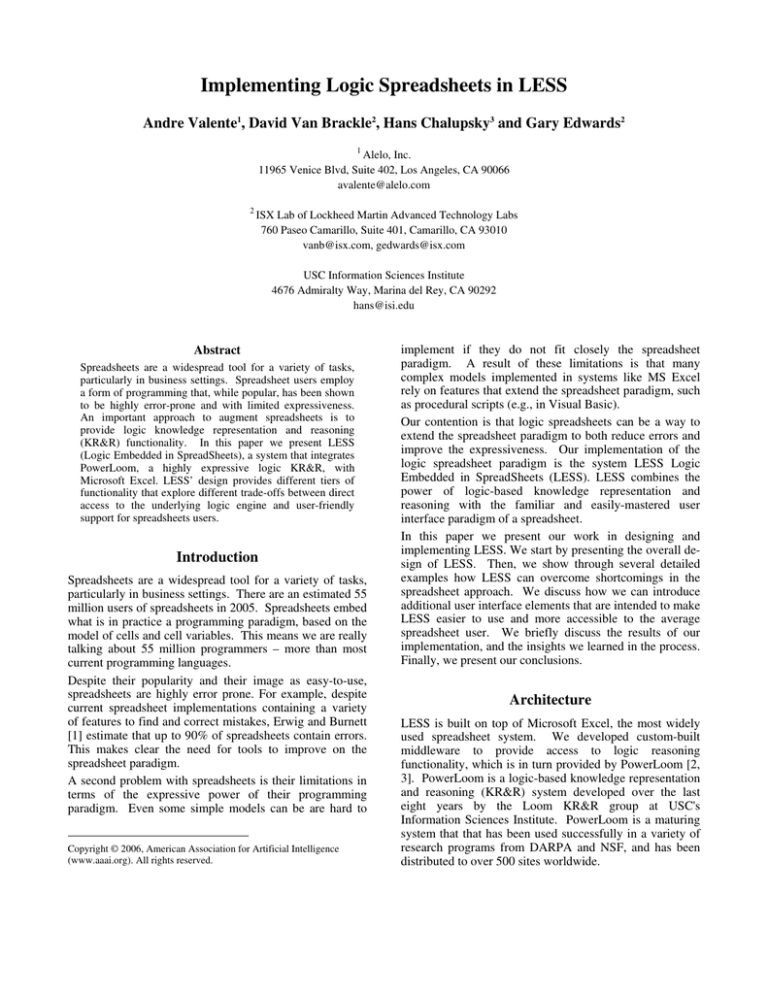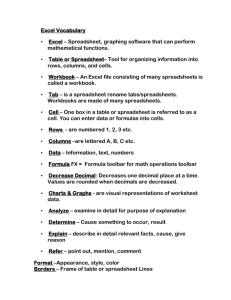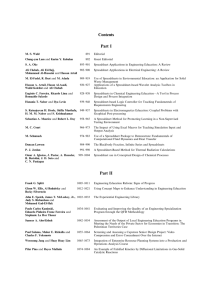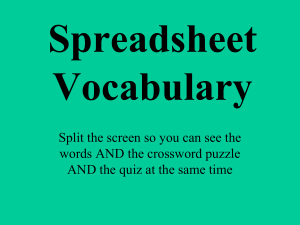
Implementing Logic Spreadsheets in LESS
Andre Valente1, David Van Brackle2, Hans Chalupsky3 and Gary Edwards2
1
Alelo, Inc.
11965 Venice Blvd, Suite 402, Los Angeles, CA 90066
avalente@alelo.com
2
ISX Lab of Lockheed Martin Advanced Technology Labs
760 Paseo Camarillo, Suite 401, Camarillo, CA 93010
vanb@isx.com, gedwards@isx.com
USC Information Sciences Institute
4676 Admiralty Way, Marina del Rey, CA 90292
hans@isi.edu
Abstract
Spreadsheets are a widespread tool for a variety of tasks,
particularly in business settings. Spreadsheet users employ
a form of programming that, while popular, has been shown
to be highly error-prone and with limited expressiveness.
An important approach to augment spreadsheets is to
provide logic knowledge representation and reasoning
(KR&R) functionality. In this paper we present LESS
(Logic Embedded in SpreadSheets), a system that integrates
PowerLoom, a highly expressive logic KR&R, with
Microsoft Excel. LESS’ design provides different tiers of
functionality that explore different trade-offs between direct
access to the underlying logic engine and user-friendly
support for spreadsheets users.
Introduction
Spreadsheets are a widespread tool for a variety of tasks,
particularly in business settings. There are an estimated 55
million users of spreadsheets in 2005. Spreadsheets embed
what is in practice a programming paradigm, based on the
model of cells and cell variables. This means we are really
talking about 55 million programmers – more than most
current programming languages.
Despite their popularity and their image as easy-to-use,
spreadsheets are highly error prone. For example, despite
current spreadsheet implementations containing a variety
of features to find and correct mistakes, Erwig and Burnett
[1] estimate that up to 90% of spreadsheets contain errors.
This makes clear the need for tools to improve on the
spreadsheet paradigm.
A second problem with spreadsheets is their limitations in
terms of the expressive power of their programming
paradigm. Even some simple models can be are hard to
Copyright © 2006, American Association for Artificial Intelligence
(www.aaai.org). All rights reserved.
implement if they do not fit closely the spreadsheet
paradigm. A result of these limitations is that many
complex models implemented in systems like MS Excel
rely on features that extend the spreadsheet paradigm, such
as procedural scripts (e.g., in Visual Basic).
Our contention is that logic spreadsheets can be a way to
extend the spreadsheet paradigm to both reduce errors and
improve the expressiveness. Our implementation of the
logic spreadsheet paradigm is the system LESS Logic
Embedded in SpreadSheets (LESS). LESS combines the
power of logic-based knowledge representation and
reasoning with the familiar and easily-mastered user
interface paradigm of a spreadsheet.
In this paper we present our work in designing and
implementing LESS. We start by presenting the overall design of LESS. Then, we show through several detailed
examples how LESS can overcome shortcomings in the
spreadsheet approach. We discuss how we can introduce
additional user interface elements that are intended to make
LESS easier to use and more accessible to the average
spreadsheet user. We briefly discuss the results of our
implementation, and the insights we learned in the process.
Finally, we present our conclusions.
Architecture
LESS is built on top of Microsoft Excel, the most widely
used spreadsheet system. We developed custom-built
middleware to provide access to logic reasoning
functionality, which is in turn provided by PowerLoom [2,
3]. PowerLoom is a logic-based knowledge representation
and reasoning (KR&R) system developed over the last
eight years by the Loom KR&R group at USC's
Information Sciences Institute. PowerLoom is a maturing
system that that has been used successfully in a variety of
research programs from DARPA and NSF, and has been
distributed to over 500 sites worldwide.
PowerLoom is one of the most expressive and powerful
KR&R systems available today, and it has many
characteristics that make it particularly adequate to
integrate into a logic spreadsheet. First, its base language is
the Knowledge Interchange Format (KIF) [4] which is
more expressive than available the languages implemented
in currently available KR systems such as description
logics, logic programming and frame-based reasoners.
Second, its engine has advanced inference capabilities such
as complex rules, negation, equality reasoning,
subsumption, and restricted forms of higher order
reasoning. PowerLoom also has a classifier that is able to
classify descriptions expressed in full first order predicate
calculus. Third, PowerLoom adopts a unique approach that
allows users to control how much of that inferential power
to use, by implementing different inference levels and
resource bounded inference. This way, a user only “pays”
for the inference power it needs to use. Fourth,
PowerLoom is available in libraries for C++, Java or
CommonLisp. Despite of PowerLoom’s inference power
and expressivity, the PowerLoom libraries are quite small.
For instance, the C++ library that is being integrated with
MS Excel takes about 7Mb. Fifth, PowerLoom's
architecture allows for modules to plug into and extend the
main PowerLoom knowledge representation system. These
facilities have been used to implement hybrid reasoners
(e.g., partial inference, simple temporal reasoning, or rule
learning), and specialized functions (e.g. units of measure),
and to integrate PowerLoom with relational databases.
These capabilities facilitate the work of integration with
the spreadsheets.
The single biggest problem in building a logic spreadsheet
is to balance how much of the integrated system is (or
feels, works like) a spreadsheet and how much it is a logicbased KR&R system. There is a natural trade-off between
keeping close to the spreadsheet paradigm and providing
more powerful ways of using logic reasoning functionality.
For example, spreadsheet users are accustomed to being
able to access data in any cell, which assumes all cells
either contain data or a formula that yields data. However,
this turns out not to be the case in logic, where most of the
action occurs indirectly, in side effects, and where the
result may not be as interesting as data. For instance, the
result of an assertion is not one of the values being asserted
but rather a logic object that is not particularly useful for
calculations. Further, spreadsheet users may balk at
learning logic in depth, and thus it is critical to provide
mechanisms to make it simpler to leverage the power of
logic-based reasoning without requiring deep expertise in
logic or knowledge representation.
Our strategy to face that challenge is to have four different
integration tiers that provide different points in this space
of trade-offs and offer alternatives that are likely to be
valuable for different types of users.
Tier 1: In this tier, logic-based knowledge representation
and reasoning systems allow users to ask questions about
knowledge in a knowledge base. The LESS system
provides an interface to allow users to make such queries
and use the results in a standard spreadsheet. Many such
queries have YES or NO answers. With LESS, users will
be able to use the results of such a query in any way they
can use any boolean result – to alter the color of cells, to
affect calculations, or in any other way now available. For
example, in a spreadsheet of servicemen, a cell might be
given a background of RED or GREEN based on a
knowledge base query to determine suitability for a given
task, or a calculation of pay may be affected by a
knowledge base query concerning training level. Users will
also be able to fill cells with the results of single-valued
queries, such as “How many hours of training has this
officer experienced in the area of Bomb damage
Assessment?”
Users are able to create, destroy, or list knowledge entities
such as concepts, instances, relations, rules or facts in the
knowledge base through functions available in formulas.
Virtually all of the functionality of PowerLoom, from the
development of concepts to creation of instances to the
specification of relations and the development of sets of
rules, is available to the spreadsheet developer to use in
formulas. For example, if an officer’s superior changes, a
formula in a cell will be able to post this new fact in the
knowledge base.
Tier 2: In this tier, LESS provides spreadsheet-based
mechanisms for viewing and modifying such knowledge in
the knowledge base, with rows representing concept
instances and columns representing the values of relations.
A simple but powerful query capability is also provided, so
that tables may be populated in different ways with extant
knowledge. Often, a user of a spreadsheet needs to build a
new sheet from an old one – for example, selecting a
collection of servicemen suitable for a given task into a
new spreadsheet, to further determine who is best for the
job. Using LESS, users are able to use knowledge in the
knowledge base for classification and to extract the
appropriate records into a new sheet.
Tier 3: At this tier, the spreadsheet is fully integrated with
the knowledge base. Any changes made in the spreadsheet
are immediately reflected in the knowledge base, and any
changes made to the knowledge base are immediately
reflected in the spreadsheet. All APIs of the logic system
are available to the spreadsheet, and all spreadsheet
functions are available to the logic system. Some
knowledge has structure that is not natural for tabular
representation. For this, LESS provides interfaces, or
wizards, which are similar to spreadsheets and which are
natural extensions to spreadsheets.
Tier 4: At this tier, LESS provides a mechanism for
capturing and reusing domain-specific knowledge. Users
are able to easily create and capture templates, containing
the structure and basic relationships of their knowledge.
They can then, perhaps at a later date, instantiate a
template, and quickly and easily parameterize it for their
current problem. Templates can even make abstract,
declarative references describing the data they need, and
can be immediately populated by automatic retrieval of
matching knowledge from the knowledge base. With
templates, users will be able to describe the structure of
their problem once and only once, and not have to expend
valuable effort each time they need to solve such a problem
with re-defining its structure. Rather, they can focus on
parameterizing and solving it. The focus is to be able to
develop and distribute precisely tailored “Domain Paks”.
For instance, bankers can produce and use a Home Loan
Domain Pak, which not only computes the loan
amortization but also helps to answer questions regarding
whether or not to allow a loan. With Domain Paks, an
expert in a given field can capture the essence of a problem
in that field, and users can utilize this problem-solving
expertise without having to characterize the problem
themselves.
At this point we have implemented Tier 1 and portions of
Tier 2 and 3. The discussion below focuses on Tier 1. An
upcoming article will discuss the other tiers in detail.
Tier 1 Examples
In this section, we will show a few examples to illustrate
how LESS works and how it can add power to standard
spreadsheets. The example spreadsheets shown are based
on real-life spreadsheets.
To facilitate exposition, the syntax used in some cases is
slightly simplified from our current implementation; we
are still adding syntactic sugar that will bridge that gap in
due time.
Example 1: A budget spreadsheet
The first example is a budget spreadsheet used by a small
business to write cost proposals using labor hours and pay
rates. A typical section of such a spreadsheet (Figure 1)
contains information about how many hours each member
of the project team will work in each task.
1
2
3
4
5
6
A
Task 1
Person
Fred
Wilma
Barney
Total
B
Jan-05
12
4
10
26
C
D
Hours
Feb-05 Mar-05
4
12
7
15
8
3
19
30
E
Apr-05
14
3
6
23
Figure 1: Typical table in a budget spreadsheet.
Normally, the sum cells (B6 to E6) have a simple formula
like =SUM(B3:B5). The disadvantage of this approach is
that it does not translate well the intent of the user, which
is to add the hours for all project members of the month.
LESS allows us to use a more declarative specification of
that intent by expressing the relationships explicitly. We
can use a logic function (hours ?person ?month ?task),
meaning the number of hours a ?person spends on a ?task
in a ?month (we use KIF syntax, with question marks
denoting variables).
In order to add relational information to a spreadsheet, we
need to add a lifting formula that expresses how the table
information corresponds to logic assertions. One way this
can be done in LESS is to add a lifting formula on top of
each column:
=ASSERTMULTI(“hours”, A3:A5, B2, $A$1)
This expands into and performs a series of assertions, e.g.:
(hours A3 B2 A1) = (hours “Fred” Jan-05 “Task
1”) = 12
(hours A4 B2 A1) = (hours “Wilma” Jan-05 “Task
1”) = 4
Once the information is lifted into PowerLoom, we can
easily express a cell as “sum the Jan-05 hours in Task 1 for
all persons” by setting cell B6 to the formula:
=SUM (RETRIEVEALL “(hours ?person Jan-05 “Task
1”)”))
Notice the mix of logic and spreadsheet functions in the
formula: SUM is the Excel function; RETRIEVALL is
function implemented by calling the logic mechanisms to
perform a PowerLoom RETRIEVE and transforming the
results into the equivalent to an Excel cell range.
We also allow a style of parametrical formulas by using
cell references in spreadsheet style, in this example:
=SUM (RETRIEVEALL “(hours ?person B2 A1)”))
A situation in which this relational (as opposed to
positional) approach shows its advantages is when the
information has more than two dimensions. This is
intuitively easy to see: since ranges cover a twodimensional space (rows and columns), a spreadsheet user
has trouble representing a relation with arity higher than 3.
For instance, let us analyze an example where a user needs
to calculate totals from information distributed across
tables (Figure 2). It shows a more complex project sheet
that contains four tables: three tables contain the hours
worked by each project member in a specific task (Task 1,
Task 2, Task 3) and the fourth contains aggregate numbers
across all tasks. The construction of the aggregate table
shows the limitations of positional referencing. Each cell
is calculated by adding one cell from each of the cells
above, e.g.: B24=B3+B10+B17
The problem is that since the information being added is
not in a simple table, we can’t use ranges. Indeed, while
such formula is easy to create for a small number of tasks,
it can easily get cumbersome if there are many tasks. (The
real-life example sheet from where this was abstracted
sheet contained 15 tasks/tables with up to 20 people each,
and it was constantly being enlarged.) Further, it is
extremely hard to maintain and error prone – for instance,
if a new task is added.
1
2
3
4
5
6
7
8
9
10
11
12
13
14
15
16
17
18
19
20
21
22
23
24
25
26
27
A
Task 1
Person
Fred
Wilma
Barney
Total
B
Jan-05
12
4
10
26
D
Hours
Feb-05 Mar-05
4
12
7
15
8
3
19
30
Apr-05
14
3
6
23
Task 2
Person
Fred
Wilma
Barney
Total
Jan-05
4
12
10
26
Hours
Feb-05 Mar-05
7
4
12
4
8
10
27
18
Apr-05
7
14
8
29
Task 3
Person
Fred
Wilma
Barney
Total
Jan-05
12
4
10
26
Hours
Feb-05 Mar-05
12
4
4
7
10
8
26
19
Apr-05
14
3
6
23
Jan-05
28
20
30
78
Hours
Feb-05 Mar-05
23
20
23
26
26
21
72
67
Apr-05
35
20
20
75
Total
Person
Fred
Wilma
Barney
Total
C
E
The letter grade calculated in column H depends of where
the numeric grade in column G lies in a number of ranges.
For instance, if a numeric grade is lower than 70, the letter
grade is D; if the numeric grade is higher than 70 but lower
than 75, the letter grade is C-, etc.
Spreadsheets like Excel allow conditionals that can be
cascaded, so such rules can be modeled with “cascades
ifs”. For example, a typical formula for cell H3 would
look like:
IF($H4<70,"D", IF($H4<75,"C", IF($H4<78,"C-",
IF($H4<80,"C+", IF($H4<85,"B-", IF($H4<88,"B",
IF($H4<90,"B+", IF($H4<95,"A-","A"))))))))
Figure 2: Tables for specifying hours in different tasks
in a budget spreadsheet.
As before, the problem is that the formula B24 =
does not translate well the intent of the user,
which is to add the hours Fred worked in all tasks in Jan-05
(or, to be more relative, to add the hours worked by project
member specified in cell B23). As we can see, while the
data each Task table can be seen as a model with two
variables (person and monthly hours), the overall set
reflects indexing in three dimensions – person, month and
task. When information needs to be aggregated across
more than two dimensions, the spreadsheet model suffers.
LESS can solve these limitations by resorting to relational
referencing – indeed, the approach to model this problem is
very similar to the approach used for the previous example.
Assuming the same lifting described earlier for each task
table, we can easily express “sum the hours in Jan-05 for
Fred in all tasks” as:
B3+B10+B17
=SUM (RETRIEVEALL ("(hours Fred Jan-05
?task)”))
This can also easily be turned in to a more spreadsheet-like
formula by using cell variables instead of data:
=SUM (RETRIEVEALL ("(hours A24 B$23 ?task)”))
Example 2: A grading spreadsheet
This example is based on a grading spreadsheet used to
calculate grades for students in a class, and which was also
used as a class exercise in teaching spreadsheets (Figure 3).
A
1
2
3
4
5
6
7
Student
Parker
May
Watson
Jameson
Osborn
B
C
Assignments
1
56
95
89
66
88
D
Tests
2
84
92
87
95
51
E
1
89
79
98
99
79
2
93
83
78
69
63
F
G
H
Exam Final
Letter
Grade Grade
Grade
90
81 B95
90 A80
86 B
69
79 C+
79
72 C-
Figure 3: Grading spreadsheet example.
This formula has three major problems. First, it is all but
unreadable, which makes it highly error-prone. Second, it
is very hard to write. When a similar example was used in
an assignment for business students at a class given by one
of the authors, 60% of the students were unable to come up
with the correct formula. Third, the formula is completely
hardwired in terms of the ranges used (e.g., 74 being the
higher bound for a C- grade). This makes it hard to
perform consistent grade adjustments by modifying the
ranges for each letter grade – a common practical need in
real-life classes.
In LESS we improve on the spreadsheet model by allowing
users to define rules explicitly and separately, and apply
the rules when needed. This helps with maintenance
problems when it is necessary to modify the rules.
In the same example, once the rules are defined, the
formula to calculate the grade letter (column H) would
become a simple query:
RETRIEVE("1 (letter-grade ", A3, " ?x)" ) )
In LESS, rules can be defined in several different ways.
The first way is to write them explicitly as shown in Figure
4. A notable difference is that there is one rule for each
letter grade, which makes the overall rule set more clear
and modular. Each cell contains one rule; the formula in
the cell is used to assert the rule in PowerLoom. In this
case all elements of the rule are instantiated. This has the
advantage that the rules are self-contained, but it makes
them also less flexile and parameterizable.
A more flexible modeling style – and one that fits well the
spreadsheet paradigm – is to use rule templates that are
defined on Excel data. For instance, Figure 5 shows how a
rule template can be defined based on abstract (non-cell)
variables, and a separate formula indicates how to bind
those logic variables to cells.
11
12
13
14
15
16
17
18
19
20
A
B
C
D
E
F
Classification rules - Version 1
!=assert((=> (>= ?x 95) (letter-grade ?x "A")))
!=assert((=> (and (< ?x 95) (>= ?x 90))(letter-grade ?x "A-")))
!=assert((=> (and (< ?x 90) (>= ?x 88))(letter-grade ?x "B+")))
!=assert((=> (and (< ?x 88) (>= ?x 85))(letter-grade ?x "B")))
!=assert((=> (and (< ?x 85) (>= ?x 80))(letter-grade ?x "B-")))
!=assert((=> (and (< ?x 80) (>= ?x 78))(letter-grade ?x "C+")))
!=assert((=> (and (< ?x 78) (>= ?x 75))(letter-grade ?x "C")))
!=assert((=> (and (< ?x 75) (>= ?x 70))(letter-grade ?x "C-")))
!=assert((=> (< ?x 70) (letter-grade ?x "D")))
defining a ``unit system''. The units in their work are
similar to the structure of relations to represent information
in tables in LESS.
The closest related work to the one presented here are the
implementations of logic spreadsheets discussed in the
Workshop on Logical Spreadsheets (WOLS'05).
A
detailed comparison between these implementations will
be discussed in detail in a forthcoming article
G
Conclusions
Figure 4: Representing individual rules in LESS.
A
B
C
D
E
F
G
H
38 Min
Max
Letter
39
95
100 A
40
90
94 A41
88
89 B+
42
85
87 B
43
80
84 B44
78
79 C+
45
75
77 C
46
70
74 C47
0
69 D
48
49 Template:
=assert((=> (and (<= ?x ??P1) (>= ?x ??P2) ((letter-grade ?x ??P3)))
50
=apply-template(B49,A39:C47)
I
Figure 5: Representing parameterized rules in LESS.
Implementation
LESS was implemented as an Excel add-in that includes
the PowerLoom C++ libraries. The whole file takes less
than 4Mb, and it is quick enough that we have not yet to
noticeably slow down Excel in the examples we have built
(some of them sizeable spreadsheets). This proved one of
our original claims, that one of the advantages of
PowerLoom is its small footprint and high speed.
Another important property of PowerLoom that proved
relevant was the ease of integration and extension. When
we started designing the integration and implementing a
prototype, it turned out that the existing APIs available in
PowerLoom were not only particularly relevant (built
precisely for this type of integration) but also easy and
quick to extend. For instance, we were able to create a
simple Excel C++ wrapper for PowerLoom in days.
PowerLoom's ease of integration was also extremely
important in allowing us to experiment with different
ideas.
Related Work
The idea of marrying spreadsheets and logic is not really
new. The interest in spreadsheets and their problems has
increase in the last few years in part fueled by the seminal
work in the analysis of spreadsheets and their problems by
Martin Erwig and his colleagues at Oregon State
University. Their initial work [1] was dedicated to the
identification of spreadsheets as a form of programming
and some of its shortcomings. Later, Abraham and Erwig
[5] proposed a system to uncover errors in spreadsheets by
LESS is a practical, real-life implementation of the concept
of logic spreadsheets. Our experience showed that logic
spreadsheets can overcome some of the limitations of
spreadsheets, as well as open the door to additional
applications for which spreadsheets alone are not wellsuited.
References
[1] Adding Apples and Oranges, Martin Erwig and
Margaret M. Burnett, 4th Int. Symp. on Practical Aspects
of Declarative Languages, LNCS 2257, 173-191, 2002
[2] R. MacGregor, H. Chalupsky, and E. Melz.
PowerLoom manual. University of Southern California,
1997.
Available
online
at
http://www.isi.edu/isd/LOOM/PowerLoom/documentation/
manual.html.
[3]. MacGregor, Robert M. ``A Description Classifier for
the Predicate Calculus'', in Proceedings Twelfth National
Conference on Artificial Intelligence, 1994.
[4] M. R. Genesereth. Knowledge Interchange Format.
Principles of Knowledge Representation and Reasoning:
Proceedings of the Second International Conference,
Cambridge, MA, pages 599-600. Morgan Kaufmann, 1991.
[5] Header and Unit Inference for Spreadsheets Through
Spatial Analyses, Robin Abraham and Martin Erwig, IEEE
Int. Symp. on Visual Languages and Human-Centric
Computing, 165-172, 2004.
Acknowledgements
The research reported here was sponsored by the DARPA
Small Business Innovative Research program and Dr.
David Gunning of the DARPA IPTO office.






